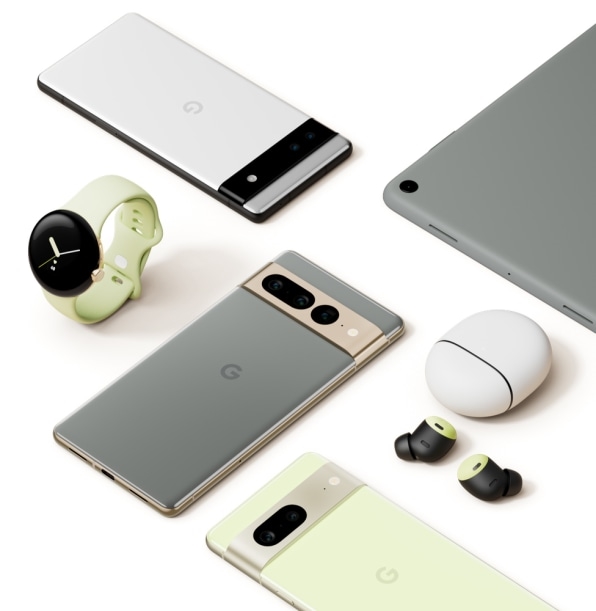Google’s Pixel Watch combines Fitbit brains and Apple Watch vibes
At its I/O developer event Wednesday, Google said it will release its own smartwatch, called the Pixel Watch, this fall. Until now Google had provided the operating systems for smartwatches, but never the watches themselves.
The Pixel Watch is built “inside and out” by Google, as Rick Osterloh, the company’s senior vice president of devices and services, put it during the keynote address. It’s also the first Google product to fully embody the technology the company purchased when it acquired fitness tracking pioneer Fitbit in a deal that was completed last year.
Design-wise, the Pixel Watch gives off serious Apple Watch vibes. Its crown and replaceable polyurethane bands look similar. The oblong button next to the crown mimics the Apple design. The recycled stainless steel. The raised crystal dome on the front. Osterloh even used some familiar Apple marketing language while introducing the Pixel: “It’s . . . glanceable, so you can be more present at home, at work, or on the go,” he said. (This suggests you can quickly wave off unimportant notifications by glancing at your wrist—results vary.) Jony Ive couldn’t have said it better.
But any mimicry seems reasonable enough. After all, given the popularity of the Apple Watch, it’s fair to say consumers have consented to these design features. Why should Google try to reinvent the wheel? And yet the Pixel does part company with the Apple Watch in a very obvious way: It’s round.
Then again, if you look at the round shape in the context of wristwatches, rather than smartwatches, it’s not radical at all. Wristwatches through the generations have mostly been round, all the way back to the days of pocket watches. Only when diodes started getting built into watches did the square shapes arrive. Some people may find that a round smartwatch gives off a less “techie” look than the Apple Watch’s “rounded square” shape.
Fitbit brains
The Pixel Watch contains Google’s Assistant, which you can ask for information such as map directions. It also contains Google Wallet, so you can make purchases or board public transportation with a raise of the wrist—no phone required. But the device’s marquee features appear to center on fitness tracking. “My favorite thing about the [Pixel] Watch is its deep integration with Fitbit,” Osterloh said.
Here, Google may have learned a marketing lesson from the market-leading Apple Watch. When Apple began selling its smartwatch in 2015, it described it as a multipurpose device that acted as an extension or remote control for the iPhone. Sales were slow at first. When the company began thinking and talking about the watch as a health and fitness device, it connected with consumers and sales increased.
Fitbit made many fitness tracker devices but it also developed an extensive software back end for tracking, sharing, and socializing around a wide array of health and fitness metrics (step counting is just the start). The Pixel Watch tracks continuous heart rate, Active Zone Minutes, exercise stats, and progress against fitness goals, as well as some sleep-quality measures, and probably some other things Google hasn’t talked about yet. (Osterloh said his company will provide more information about the Pixel Watch during the months leading up to launch.)
A better Apple alternative
But why would Google make its own watch when it’ll be competing with the Android-powered watches of its partners?
Google launched its Android Wear operating system for wearable devices back in 2014, hoping that partners such as Samsung, Motorola, and HTC would go forth and make smash hit Wear-powered smartwatches (it’s now called Wear OS). But the market for Android smartwatches was tepid from the start.
“They want there to be showcase devices that are examples of the best experience/implementation in the hopes it spurs the ecosystem,” says Ben Bajarin, principal analyst at market research firm Creative Strategies, in a message to Fast Company Wednesday.
“This is probably even more important in the area of smartwatches, where their partners have struggled to gain any traction,” Bajarin says. “Google needed to do this to help kick-start broader support for their WearOS platform and it makes sense to do something specific to Pixel and the Pixel hardware ecosystem, which is clearly broadening.”
Broadening indeed. Aside from the Pixel Watch, Google announced a new pair of earbuds called the Pixel Buds Pro, as well as a new smartphone called the Pixel 6a. Since it’ll be important that the Pixel Watch integrate and interact easily with these and other Google hardware devices, the Android team announced a number of improvements that’ll let Google devices pair and share content with each other more easily and securely.

(36)

